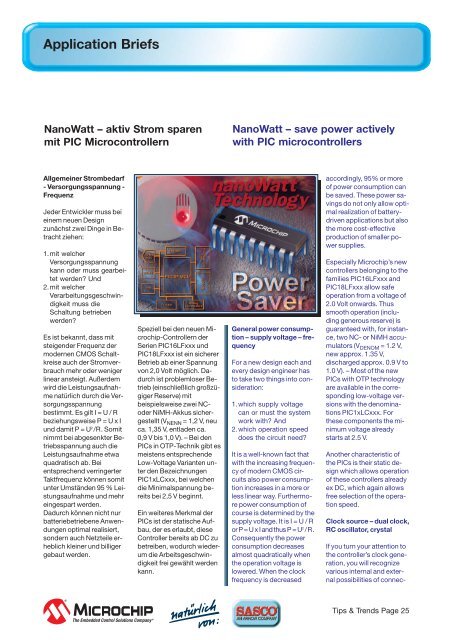SASCO Information & News - ISI-Design
SASCO Information & News - ISI-Design
SASCO Information & News - ISI-Design
Erfolgreiche ePaper selbst erstellen
Machen Sie aus Ihren PDF Publikationen ein blätterbares Flipbook mit unserer einzigartigen Google optimierten e-Paper Software.
Application Briefs<br />
NanoWatt – aktiv Strom sparen<br />
mit PIC Microcontrollern<br />
Allgemeiner Strombedarf<br />
- Versorgungsspannung -<br />
Frequenz<br />
Jeder Entwickler muss bei<br />
einem neuen <strong>Design</strong><br />
zunächst zwei Dinge in Betracht<br />
ziehen:<br />
1.mit welcher<br />
Versorgungsspannung<br />
kann oder muss gearbeitet<br />
werden? Und<br />
2.mit welcher<br />
Verarbeitungsgeschwindigkeit<br />
muss die<br />
Schaltung betrieben<br />
werden?<br />
Es ist bekannt, dass mit<br />
steigender Frequenz der<br />
modernen CMOS Schaltkreise<br />
auch der Stromverbrauch<br />
mehr oder weniger<br />
linear ansteigt. Außerdem<br />
wird die Leistungsaufnahme<br />
natürlich durch die Versorgungsspannung<br />
bestimmt. Es gilt I = U / R<br />
beziehungsweise P = U x I<br />
und damit P = U 2 /R. Somit<br />
nimmt bei abgesenkter Betriebsspannung<br />
auch die<br />
Leistungsaufnahme etwa<br />
quadratisch ab. Bei<br />
entsprechend verringerter<br />
Taktfrequenz können somit<br />
unter Umständen 95 % Leistungsaufnahme<br />
und mehr<br />
eingespart werden.<br />
Dadurch können nicht nur<br />
batteriebetriebene Anwendungen<br />
optimal realisiert,<br />
sondern auch Netzteile erheblich<br />
kleiner und billiger<br />
gebaut werden.<br />
Speziell bei den neuen Microchip-Controllern<br />
der<br />
Serien PIC16LFxxx und<br />
PIC18LFxxx ist ein sicherer<br />
Betrieb ab einer Spannung<br />
von 2,0 Volt möglich. Dadurch<br />
ist problemloser Betrieb<br />
(einschließlich großzügiger<br />
Reserve) mit<br />
beispielsweise zwei NCoder<br />
NiMH-Akkus sichergestellt<br />
(V NENN = 1,2 V, neu<br />
ca. 1,35 V, entladen ca.<br />
0,9 V bis 1,0 V). – Bei den<br />
PICs in OTP-Technik gibt es<br />
meistens entsprechende<br />
Low-Voltage Varianten unter<br />
den Bezeichnungen<br />
PIC1xLCxxx, bei welchen<br />
die Minimalspannung bereits<br />
bei 2,5 V beginnt.<br />
Ein weiteres Merkmal der<br />
PICs ist der statische Aufbau,<br />
der es erlaubt, diese<br />
Controller bereits ab DC zu<br />
betreiben, wodurch wiederum<br />
die Arbeitsgeschwindigkeit<br />
frei gewählt werden<br />
kann.<br />
NanoWatt – save power actively<br />
with PIC microcontrollers<br />
General power consumption<br />
– supply voltage – frequency<br />
For a new design each and<br />
every design engineer has<br />
to take two things into consideration:<br />
1.which supply voltage<br />
can or must the system<br />
work with? And<br />
2.which operation speed<br />
does the circuit need?<br />
It is a well-known fact that<br />
with the increasing frequency<br />
of modern CMOS circuits<br />
also power consumption<br />
increases in a more or<br />
less linear way. Furthermore<br />
power consumption of<br />
course is determined by the<br />
supply voltage. It is I = U / R<br />
or P = U x I and thus P = U 2 /R.<br />
Consequently the power<br />
consumption decreases<br />
almost quadratically when<br />
the operation voltage is<br />
lowered. When the clock<br />
frequency is decreased<br />
accordingly, 95% or more<br />
of power consumption can<br />
be saved. These power savings<br />
do not only allow optimal<br />
realization of batterydriven<br />
applications but also<br />
the more cost-effective<br />
production of smaller power<br />
supplies.<br />
Especially Microchip’s new<br />
controllers belonging to the<br />
families PIC16LFxxx and<br />
PIC18LFxxx allow safe<br />
operation from a voltage of<br />
2.0 Volt onwards. Thus<br />
smooth operation (including<br />
generous reserve) is<br />
guaranteed with, for instance,<br />
two NC- or NiMH accumulators<br />
(V DENOM = 1.2 V,<br />
new approx. 1.35 V,<br />
discharged approx. 0.9 V to<br />
1.0 V). – Most of the new<br />
PICs with OTP technology<br />
are available in the corresponding<br />
low-voltage versions<br />
with the denominations<br />
PIC1xLCxxx. For<br />
these components the minimum<br />
voltage already<br />
starts at 2.5 V.<br />
Another characteristic of<br />
the PICs is their static design<br />
which allows operation<br />
of these controllers already<br />
ex DC, which again allows<br />
free selection of the operation<br />
speed.<br />
Clock source – dual clock,<br />
RC oscillator, crystal<br />
If you turn your attention to<br />
the controller’s clock generation,<br />
you will recognize<br />
various internal and external<br />
possibilities of connec-<br />
Tips & Trends Page 25




